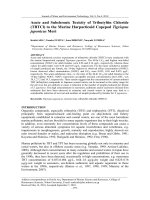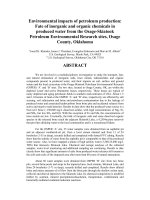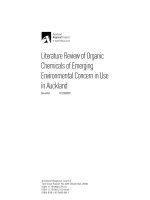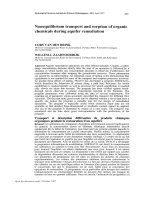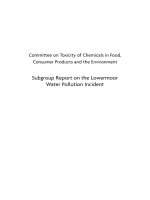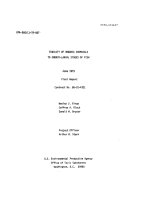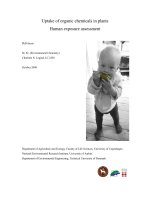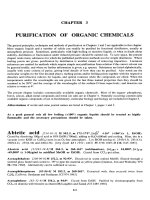TOXICITY OF ORGANIC CHEMICALS TO EMBRYO-LARVAL STAGES OF FISH potx
Bạn đang xem bản rút gọn của tài liệu. Xem và tải ngay bản đầy đủ của tài liệu tại đây (2.59 MB, 71 trang )
EPA-560/11-7~-007·
TOXICITY
OF
ORGANIC
CHEMICALS
TO
EMBRYO-LARVAL
STAGES
OF
FISH
June
1979
Final
Report
Contract
No.
68-01-4321
Wesley
J.
Birge
Jeffrey
A.
Black
Donald
M.
Bruser
Project Off;cer
Arthur
M.
Stern
U.S.
Environmental
Protection
Agency
Office of
Toxic
Substances
Washington,
D.C.
20460
PBPO-10I637
'-'~
.
TECHNICAL
REPORT
DATA
(pt_l'IltI.tll~tiImJ
or. the
TPUJ.
btt/Dnl t:ompll1tiJf8J
1.
RepORT
iIIO.
12.
:'3.
RECIPIENT'S
ACCES$IONroNO.
EPA-560/11-79-007
PI:)
Y()
-
/f!)
/c
3 '7
4.
TITLE
ANO
SUBTITLE
I.
REPORT
DATE
I
Toxicity of
Organic
Chemicals
to
Embryo-Larval
June
1979
(Date
of Issue)
$tages of Fish
lJ.
PEFlIIOAMINQ
OFlGANlZATION
CODe
7.
AUTHOAlSJ
~.
PERFOAMING
ORGANIZATION
REPOAT
NC
.
~
Wes
1
ey
J.
Bi
rge, Jeffrey A•
Black,
and
Donald
M.
Bruser
•
I.
PERFORMING
ORGANIZATION
NAME
AND
AOOFlES$
10.
PROGRAM
ELeMENT
NO
•
rhomas
Hunt
Morgan
School
of Biological
Sciences
University of
Kentucky
.
11.
C1JNTftA~/(iI'lANT
NO.
~ex1ngton,
KentuckY
40506
68
01-4321
.
.
12.
SPONSOAING
AGENCY
NAME
AND
AOORESS
13.
TYPE
OF
REPORT
AND
PERIOD
COVERED
pff1ce of
Toxic
Substances
Final
(Oct.
1976-Feb.
1979)
~~S.
Environmental
ProteCtion
Agency
,
SPONSORING
AGENCY
cooe
~ashfngton,
D.C.
20460
.
.
1
••
SUPPL&MENTAAY
NOTES
.
,
1lJ.AATftACTA
continuous
flow
procedure
was
developed
for evaluating effects of insoluble
and
volatile organics
on
embryo-larv&l
stages of fish. Test
compounds
were
selected
for different
combinations
of'solubility
and
volatility
and
included aniline, atrazine,
chlorobenzene, chloroform, 2,4-dichlorophenol, 2,4-dichlorophenoxyacetic acid,
d10ctyl
~hthalate,
malathion, trisodium
nitrilotriacetic
acid, phenol,
and
polychlorinated bi-
phenyl
(Capacitor 21). Aclosed
system
devoid
of standing
air
space
greatly
reduced
volatility
as
a
test
variable.
Mechanical
homogenization
proved
highly effective in
suspending
hydrophobic
compounds
in
influent water.
Continuous
agitation in the
test
chamber\nd regulation of detention
time
further'precluded the
need
for
carrier
sol-
vents. Test results indicated
good
reproducibility of
exposure
concentrations.
The
most
toxic
compounds
included Capacitor 21, chlorobenzene, 2,4-dichlorophenol,
and
phenol:
Chlorobenzene
at
90
pg/l
produced
complete
lethality of trout eggs.
The
three
other
compounds
gave
log
probit
LCSO's
of 2 to
70
ug/l
when
trout stages
were
exposed
in
hard
water,
and
LCII,swere
0.3, 1.0,
and
1.7 pg/l for
phenol
t Capacitor
21,
and
2,4~di-
chlorophenol.
Chloroform
also
was·
highly toxic to trout stages
and
Lells
ranged
from
4.9 to 6.2
Ug/1.
-When
bass
and
goldfish stages
w~re
exposed
to chlorobenzene, LCl's
ranged
from
8 to
33
pg/l.
Compared
to other species, trout
developmental
stages gener-
ally
exhibited the greatest sensitivity.
The
LCI
values
determined
in embryo-larval
tests
compared
closely
with
maximum
acceptable toxicant concentrations
developed
in
Hf,,_rvrlA
dwH
tIl!
"'net'
~2hlD
ies
nf
teratic
larvae
I
.
17.
KEY
WORDS
AND
DOCUMENT
ANAl.
YSIS
iI.
oeSCFlU"TOFlS
b.IOENTIFIEFlS/OPEN
ENDED
TEAMS
Co
(;OSATI
Field/G:oup
Toxicity Tests
-
Embryos
Larvae
Embryonic
Lethality
Freshwater
Fish
larval Lethality
Bioassay
Teratogenesis
Terata
Organic
,Toxicants
Organic
Compounds
Volatile
Organics
Insolubl~
~rganics
Water
Quality
ICarr;-r
SolYe~ts
i
1a.
DISTRIBUTION
STATEMENT
19.5ECUFUTY
CLASS
{nli:l
Rl1pOITJ
21.
NO.
OF
PAGiiS
I
Unclassified
'12.
Release
Unlimited
20.
SECURITY
Cl \SS
(Thu
pap)
22.l"RICEA:?
A1J
tt-
I
Unclassified
/)1F-HOl
NOTICE
This report
has
been
reviewed
by
the Office of
Toxic
Substances,
EPA,
and
approved
for publication.
Approval
does
not signify
that
the contents
nec~ssar1ly
reflect
the
views
and
policies of the
Environmental
Protection
Agency,
nor
does
mention
of trade
names
or
commercial
products constitute
indorsement
or
recommendation
for use.
;1
ABSTRACT
A continuous
flow
procedure
was
developed
for
evaluating
effects
of
insoluble
and
volatile
organics
on
embryo-larval stages
of
fish.
A closed
system
devoid
of
standing
air
space
was
used
to
minimize
volatility
as a
test
variable.
!nsoluble
compounds
were
suspended in influent water
by
mechanical
homogeniza-
tion_ without the
use
of
carrier
solvents. Tests
were
performed
on
aniline,
atrazlne,
chlorobenzene, chloroform, 2,4-dichlorophenol, 2,4-dichlorophenoxy-
acetic
acid (2,4-0), dioctyl phthalate
(OOP),
malathion, trisodium
nftrllo-
triacetlc
acid
(NTA),
phenol,
and
polychlorinated biphenyl (Capacitor 21).
Maintaining water hardness
at
50
and
200
mg/l
CaC0
3
,
exposure
was
continuous
from
fertilization
through 4
days
posthatching for largemouth bass, bluegill
sunfish, channel
catfish,
goldfish,
rainbow
trout,
and
redear sunfish.
Exposure
levels
which
produced
50%
(Le
SO
)
and
1%
{LeI}
control-adjusted
impairment
(lethality,
teratogenesis) of
test
populations
were
calculated
by
log probit analysis.
The
LCI's
were
used
as
a basis for estimating threshold
concentrations for toxic
effects.
To
determine
reliability
of
LC
I
values, they
were
compared
with
maximum
acceptable toxicant concentrations
(MATC)
developed
in
partial
and
complete
life-cycle
studies.
Good
correlations
were
obtained
when
data
were
adequate to permit comparisons,
and
the findings indicated
that
LC
I
values determined
in
embryo-larval
tests
carried through 4
days
posthatching
were
useful in estimating long-term
@-jrfects
of aquatic pollutants.
Test
results
indicated
good
reprQducibility of exposure concentrations
for
both
volatile
and
insoluble toxicants.
The
most
toxic
compounds
included
Capacitor
21, chlorobenzene, 2,4-dichlorophenol,
and
phenol.
Chlorobenzene
at
90
pg/l
produced
complete
lethality
of trout eggs,
and
LCI's
ranged
from
8 to
33
pg/l in
tests
with the largemouth bass
and
goldfish.
The
tnree
other
compounds
gave
log probit
lCSO'S
of 2 to
70
pg/l
when
trout stages
were
exposed
1n
hard
water,
and
LeI's
were
0.3,
1.0,
and
1.7 pgll for phenol,
Capacitor 21,
and
2,4-dichlorophe~01.
Phenol
was
less toxic
to
developmental
stages of the goldfish
and
bluegill.
When
tests
were
conducted in hard water,
the
LCSO'S
were
0.34
and
1.69
mg/l
and
the
LC
1
's
varied
from
2.0
to
8.8
~g/l.
Depending
on
water hardness, LCI's determined in P9/l with the
rainbow
trout
iii
ranged
from
4.9 to 6.2 for chloroform,
21.9
to
32.5
for 2,4-0,
and
29.0
to
77.2
for atraztne.
Though
not tested
on
the trout,
LCt'S
determined
with
the
goldfish
ranged
from
143.2
to
215.0
~g/l
for aniline
and
141.1
to
439.6
~g/l
for malathion.
The
organics least toxic to the trout included
NTA
and
COP.
and
the
LCSO's
varied
from
90.S
to
114.0
and
139.5
to
149.2
mg/l, respectively.
Compared
to the other species, trout
developmental
stages generally exhibited
the greatest overall sensitivity.
Though
water
hardness
did
not
substantially
alter
toxicity of the selected organic
compounds.
phenol
was
somewhat
more
toxic
1n
hard
water.
All
compounds
produced
appreciable frequencies of
teratic
larvae.
•
tv
TABLE
OF
CONTENTS
. . . .
.
,.
.
iii
vi
vii
viii
1
3
5
7
7
7
7
9
10
12
14
20.
24
24
24
26
26
27
28
28
29
30
30
31
32
••
35
36
56
· . .
· . .
· . .
· . .
. .
· . .
· .
.,
.
·
. .
· . .
· . .
· . .
·
. . .
. . .
.
.
.
. .
· .
.,
.
·
. .
· . . .
. . . .
. .
.
. .
.
. .
. . .
. .
. . . . .
Teratogenesis in Fish
Embryos
.
SUMfttA.RY
• • • • • • •
••
" • •
REFERENCES
.•
. . . • • • • . . . • . •
ABSTRACT
.••
LI
ST
OF
TABLES
••.••••••.••
LIST
OF
FIGURES
• • • • . • . •
ACKNOWLEDGMENTS
.
INTRODUCTION
.••
CONCLUS
IONS
• • . • • • •
RECOMMENDATIONS
• • • • • • • • • .
DEVELOPMENT
OF
TEST
SYSTEM
AND
PROCEDURES
• .
Materials
and
Methods
••••••••••
Selection of
animal
species • • • . • . • •
Selection of
organic toxicants
••••••.
Test conditions
and
expression of data
Test water • • • . • • • • • . • • • •
Embryo-larval
test
system
.•••••
Analytical procedures
•••••
Initial
Performance
Evaluation
APPLICATION
OF
TEST
SYSTEM
• . .
Embryo-Larval
Toxicity Tests
Aniline • • • • •
••
Atrazine • • • • • • . • • •
Capacitor
21
• • • .
Ch
lorobenzene •
•
Chloroform
• • • • • • • . • •
2,4-Dichlorophenol
•.•••••
2,4-Dichlorophenoxyacetic acid
Dloctyl phthalate
••.•.•••
Malathion
•••••••••••••.•
Trisodium
nitrilotriacetic
acid
•••••••
Pheno
1
••••••••••
v
LIST
OF
TABLES
Table
8
"
e:;
49
52
54
50
51
48
11
13
23
38
. .
• . • . 55
• • • .
22
. .
. .
Organic
compounds
used
1n
toxicity
tests
•••••••••
Toxicity
tests
performed
on
embryo-larval stages of fish
Water
quality characteristics
observed
during toxicity
tests
with organic
compounds
Reconstituted
test
water • •
•.••• ••
Regulation
of
Sudan
IV-chlorobenzene
1n
continuous
flow
tests
'!'"
Regulation of organic
compounds
1n
continuous
flow
toxicity
tests
with fish embryo-larval stages
Log
problt
LCSO
values for organic
compounds
Log
probit
LCI
values
determined
at
4
days
posthatchlng for organic
compounds
. • • • • •
41
Toxicity of aniline to embryo-larval stages of fish
43
Toxicity of atrazine to embryo-larval stages of fish
44
Toxicity
of
Capacitor
21
to embryo-larval stages of fish
••••
45
Toxicity
of
chlorobenzene to embryo-larval stages of fish • • . •
46
Toxicity of chloroform to embryo-larval stages of
rainbow
trout.
47
Toxicity
of
2,4-dichlorophenol
(DCP)
to embryo-larval stages
of
fish • • • • •
•.•.•
Toxicity
of
2,4-dichlorophenoxyacetic acid (2,4-0)
to embryo-larval stages of fish .
Toxicity
of
dioctyl phthalate
(DOP)
to embryo-larval stages of
fish.
Toxicity of malathion to embryo-larval stages of goldfish
••
Toxicity of trisodium
nitrilotriacetic
acid
(NTA)
to embryo-larval stages of fish
••••••••
Toxicity of
phenol
to embryo-larval stages of fish
Comparison
of LeI's
determined
in
embryo-lar~~:
tests
wi
th
MATt
I S der;
ved
from
1ife-eye1e s
tu'~
I
es
7
8
1
2
3
4
5
6
19
20
17
18
15
16
9
10
11
12
13
14
vi
LIST
OF
FIGURES
Figure
1
Embryo-larval
test
system
.•••••• ••
2
Multichannel
assembly
of toxicity
test
units
3
Exposure
chamber
. • • • • • • . • • • • • •
4 Toxicity of aniline to fish
eggs
•.• •
5 Effect of water
hardness
on
phenol
toxicity to trout
eggs
vii
15
17
•
••
19
25
33
ACkNOWLEDGMENTS
The
authors are grateful to
A.G.
Westerman.
W.E.
McDonnell,
M.C.
Parekh,
and
J.E.
Hudson
for technical support
and
to
Barbara
A.
Ramey
for preparation
of the manuscript
and
figures.
We
also are appreciative of
Dr.
Arthur
Stern
for his assistance
during
this study.
The
research
facilities
used
to
conduct
these
tests
were
provided
in
part
by
research
funds
from
the
U.S.
Department
of
the Interior, Office of
Water
Research
and
Technology
(grant
no.
A-074-KY)
and
the
National
Science
Foundation
(grant
no.
AEN
74-08768-AOl)
.
•
viii
1
INTRODUCTION
The
toxicological characterization of organic pollutants
is
frequently
complicated
by
physical
and
chemical
properties
of
the
test
compounds
(Schoor,
1975;
Veith
and
Comstock.
1975). Volatility or
low
water solubility
may
preclude adequate regulation of
exposure
concentrations
in
aquatic
test
systems,
especially
when
open
test
chambers
are used.
Though
emulsifiers or
carrier
solvents
may
be
of
some
aid
in
testing
hydrophobic
organics, they generally
introduce undesirable variables.
The
initial
objective of this investigation
was
to
develop
a continuous
flow
system
designed for testing volatile
and
insoluble organic
compounds
which
are
difficult
to stabilize
with
conventional
techniques.
Using
fish embryo-larval stages
as
test
organisms, a closed
flow-
through
test
ch~~ber
devoid
of
an
air-water interface
was
used
to
minimize
evaporative loss
of
volatile
organic~.
Insoluble
compounds
were
suspended
in
influent water
by
mechanical
homogenization,
and
maintained
by
continuous
agitation in the
exposure
chamber
and
regulation of detention time.
Fish
embryos
were
selected
as
test
organisms
because
of
their
simple
culture require-
ments,
suitability
for
use
in a closed
test
system,
and
high
sensitivity to
aquatic contaminants. Reconstituted water, with
physicochemical
characteristics
representative of natural freshwater,
was
formulated to provide stable,
reproducible
test
conditiQns
and
to
minimize
problems
with
background
contami-
nants.
In
the process
of
developing the
new
procedures, tests
were
performed
with eleven organic
compounds,
selected for varying degrees of
volatility
and
water solubility (Table
1).
Table
1.
Organic
compounds
used
1n
toxicity
tests.
Compound
Aniline
Atrazine
Capac1tor'l'M
21
1
Chlorobenzene
Chlorofonn
2,4-0ichlorophenol
2,4-0ichloro-
phenoxyacetic acid
Oioctyl
phthalate
Malathion
Trisodium
nitrilo-
triacetic acid
Phenol
Formula
~HCHCHCHCH~NH2
, i
CXCXCXCXCXCCCXCXCXCXCX
t '
x=
C1
or
H
CHCHCHCHCHCCl
Low
'
CHC1
3
CC1CHCC1CHCHCOH
t ,
~{OCH2COOH)CC1CHCC1CH1H
~(COOC8H17)C(COOC8H17)CHCHCH9H
CHCHCHCHCHCOH
, t
Company
J.T.
Baker
Chemical
Co.
Phillipsburg,
N.J.
ICN
Pharmaceuticals, Inc.
Plainview
7
N.Y.
Monsanto
Co.
St. Louis,
Mo.
J.T. 9aker
Chemical
Co.
Phillipsburg
7
N.J.
Fisher Scientific
Co.
Fair
Lawn,
N.J.
Aldrich
Chemical
Co.
Milwaukee
7
Ws.
Aldrich
Chemical
Co.
Milwaukee,
Ws.
U.S.
Steel
Chemicals
Div.
Pittsburgh,
Pa.
American
Cyanamid
Co.
Princeton, N.J.
ICN
Pharmaceuticals, Inc.
Plainview,
N.Y.
J.T.
Baker
Chemical
Co.
Phillipsburg,
N.J
•
•
lTrademark
of the
Monsanto
Co., St. Louis, Missouri.
3
CONCLUSIONS
A continuous
flow
system
was
developed
for testing insoluble
and
volatile
organic
compounds
on
embryo-larval stages of
fish.
Use
of a closed
test
system,
devoid
of
an
air-water interface greatly
reduced
volatility
as
a
test
variable.
Fluctuations in exposure concentrations
were
no
greater for chloroform than for
nan-volatile
compounds.
Mechan1cal
homogenization
proved
highly effective
1n
suspending
hydrophobic
compound~
in
influent water. Continuous,
moderate
agitation in the
test
chamber
and
regulation
of
detention
time
further precluded
the
need
for
carrier
solvents. Fish
eggs
and
larvae
were
easily maintained in
the closed
system,
and
there
was
no
evidence that this procedure altered
test
responses.
Numerous
classes of organic
compounds
were
found
to
be
highly toxic
and
teratogenic to
developmental
stages of
fish.
Of
eleven
compounds
tested, those
which
proved
most
toxic to eggs,
embryos,
and
early larvae included chlorobenzene,
2,4-dichlorophenol, phenol,
and
polychlorinated biphenyl (Capacitor 21). Chloro-
benzene
at
90
pg/l
produced
complete
lethality
of
tro~t
eggs,
and
LCI's
ranged
from
8 to
33
pg/l in
tests
with the
largemouth
bass
and
goldfish.
The
three other
compounds
gave
log
probit
LC
50
's
of 2 to
70
pg/l
when
trout
stages
were
exposed
in
hard
water,
and
LCI's
were
0.3, 1.0,
and
1.7 ug/1 for
phenol, Capacitor 21,
and
2,4-dichlorophenol.
Phenol
was
le'5
toxic
to
develop-
mental
stages
of
the goldfish
and
bluegill.
The
LCSO's
wer
0.34
and
1.69 mgjl
when
tests
were
conducted
in
hard
water,
and
the LCI's varied
from
2.0
to 8.8
Ug/l.
Depending
on
water hardness,
LCI's
(~gjl)
determined
with
the
rainbow
trout
ranged
from
4.9 to 6.2 for chloroform, 21.9 to 32.5 for 2,4-0,
and
29.0
to 77.2 for atrazine.
Though
not tested
on
the
trout,
LeI'S determined with
the goldfish
ranged
from
143.2
to
215.0
pg/l
for
aniline
and
141.1
to 439.6 pg/l
for malathion.
The
least
toxic
compounds
included
NTA
and
nop.
In
tests
with
trout
developmental
stages, the
LCSO'S
varied
from
90.5 to
114.0
and
139.5 to
149.2
mg/l, respectively.
Though
phenol
was
somewhat
more
toxic
in
hard
water,
hardness
was
not
an
appreciable factor
in
most
tests.
On
the basis
of
these data,
it
was
evident
that
chlorinated aromatic
hydrocarbons
were
among
the
most
toxic
compounds.
These
findings are consistent
4
with other studies
which
also
have
shown
that
numerous
chlorinated aromatic
hydrocarbons
exert
marked
effects
on
fish reproduction, often accumulating to
high
levels in
eggs
and
tissues (Birge,
et
!l.,
1979b).
Only
chloroform
and
phenol
exhibited
comparable
effects
on
fish embryo-larval stages.
Chloroform,
a solvent of
high
lipid
solubility,
is
a narcotizing agent,
and
phenol, a
widely
used
germicide,
is
an
effective protein denaturant.
Of
three
monosub-
stituted
benzene
compounds
tested
(i.~.,
aniline, chlorobenzene, phenol),
. .
toxicity varied with the different substitution groups, generally increasing
in the order
NH
2
,
OH,
and
CI.
It
was
further
concluded
that
log
probit analysis
could
be
successfully
applied to dose-response data to determine threshold concentrations
(LeI)
at
which
organic
compounds
become
lethal or teratogenic to embryo-larval stages.
In
addition,
when
exposure
was
maintained
from
fertilization
through
4
days
posthatching
and
responses for
lethality
and
teratogenesis
were
combined,
LeI's
provided a close approximation to
maximum
acceptable toxicant concentrations
(MATC)
determined in partial
and
complete
life-cycle
tests
(Table
20).
Developmental
stages of the different fish species usually exhibited
differential
sensitivity
to the various organic toxicants.
Though
the order
of specles
sensitivity
varied
somewhat
with different
compounds,
trout
embryos
and
alevins generally.exhibited the
least
tolerance. Differences
between
LeI
values determined for the
trout
and
other species frequently
exceeded
one
and
sometimes
two
orders of
magnitude.
Less
variation occurred
among
the five
remaining
species,
and
the goldfish often
was
the
most
tolerant.
5
RECOMMENDATIONS
Cons1.deration
should
be
given
to revising the protocol for embryo-larval
tests,
to provide technological
improvements
which
will ensure
1)
more
adequate
regulation of exposure concentrations of volatile toxicants,
and
2)
testing of
hydrophobic
compounds
under
conditions
which
minimize
or preclude the
need
for
carrier
solvents. Additional study
is
recommended
to
modify
the
new
procedure
described herein to
accommodate
1)
testing of organics
which
exist in the
gaseous
state
at
ambient
temperatures,
and
2)
use
of a wider variety of
test
organisms
(e.a.,
Daphnia.
juvenile
fish).
Several
halomethanes
included
among
the
129
prior-
ity
toxicants
listed
by
EPA
have
boiling points
which
range
from
-29
to
+4.S
o
C
(~.a.,
methyl
chloride,
methyl
bromide,
dichlorodifluoromethane). Consequently,
such
compounds
cannot
be
stabilized adequately in conventional
open
aquatic
test
systems.
However,
the closed flow-through procedure described
in
the present
study
could
be
further adapted to
facilitate
such
testing.
Gases
would
be
dis-
persed in influent water using the
mixing
assembly,
and
test
water
would
be
per-
fused
continu~usly
through
the closed
exposure
chamber.
Moderate.agitation in
the
exposure
chamber
and
regulation of detention
time
would
further
augment
homo-
. "
geneous
dispersal
of
toxicant
in
test
water.
The
new
procedure
also
could
be
effectively modified to permit
use
of
Daphnia
and
other aquatic species in
tests
with volatile
and
hydrophobic
compounds
which
are
difficult
to
stabilize
using
conventional procedures.
Convincing
evidence
has
been
presented that fish embryo-larval
tests
which
extend
bey~nd
hatching
by
30
days
or
more
yield responses
comparable
to those
produced
in
chronic life-cycle studies
(McKim,
1977).
However,
considering the
many
contaminants
which
actually or potentially
may
enter aquatic ecosystems,
still
shorter
and
more
cost-feasible
tests
are
needed
for
environmental
assessments.
In
the'present investigation,
when
embryo-larval
tests
were
carried
through
4
days
posthatching
and
frequencies of
lethality
and
teratogenesis
were
combined,
log
.probit
LCI's
were
in
good
agreement
with
MATC's
developed
in chronic life-cycle
studies.
These
data indicated that embryo-larval
tests
of shorter duration than
those presently
recommended
(U.S.
EPA,
1978)
may
prove
valuable
in
estimating
long-term effects
of
aquatic toxicants. Accordingly,
it
may
be
appropriate
to
consider revising
exposure
periods specified
in
the present protocols for
embryo-
larval testing
(U.S.
EPA.
1978).
6
In
add~tfon,
further attention should
be
given
to
use
of
lC
I
values in
detennin1ng water quality
criteria.
Unlike
the
MATC
which
generally
is
expressed
as the range
between
the lowest toxic
and
highest no-effect concentrations, the
lC
I
represents a discrete value for
which
reliable confidence limits
can
be
established. Furthermore,
it
may
prove
useful to calculate lCIO's
which
could
be
used
in conjunction
with
LC
I
values to characterize slope of the threshold
end
of the dose-response
curve
and
to provide
an
additional reference point for
establishing
regulato~
criteria.
Provided
that
the
number
of
exposure
concentrations
is
sufficient to
delineate
an
adequate dose-response curve,
lC
I
values
can
be
calculated
with
present
log
probit
programs.
However,
as
existing probit
methods
were
designed
primarily for calculating
lC
SO
values (Finney,
1971;
Stephan, 1977), attention
should
be
given
to the
development
of
new
regression procedures formulated
especially to delineate near-threshold concentrations
(~.~.,
LC
IO
'
LC
I
).
7
DEVELOPMENT
OF
TEST
SYSTEM
AND
PROCEDURES
Materials
and
Methods
Selection
Bf
animal species. Fish
used
in
this
study included the bluegill
'sunfish
(Lepomis
macrochirus),
channel
catfish (Ictalurus punctatus), goldfish
(Carasslus auratus),
largemouth
bass
(Micropterus salmoides),
rainbow
trout
(Salmo
gairdneri),
and
redear sunfish
(lepomis
microlophus). Species
were
chosen
fQr
economic
importance, seasonal
availability,
suitable
egg
production,
and
for variat10ns in ecological
and
geographic distribution, including
warm
and
cold water habitats.
This
selection also included species
with
different
patterns of reproduction, involving a
number
of
developmental
variables
which
may
respond
differentially
to organic toxicants
(~.~.,
yolk quantity, hatching
time,
spawning
habits).
Gravid
rainbo~
trout
were
provided
by
the
Erwin
National
Fish
Hatchery,
Erwin,
Tennessee.
Eggs
and
sperm
were
obtained
by
artificial
spawning
and
milking procedures of
Leitritz
and
lewis (1976). Fertilization
was
accomplished
by
mixing
eggs
and
milt for 20
min.
Freshly
fertilized
eggs
from
bass, bluegill.
goldfish,
and
redear sunfish
were
collected locally
from
the Frankfort National
Fish Hatchery, Frankfort,
Kentucky.
Channel
catfish
spawn
was
obtained
from
either
the Frankfort
Hatchery
or the Senecaville National
Fish
Hatchery,
Senecaville,
Ohio.
Selection of organic toxicants. Toxicity tests
were
conducted
with aniline,
atrazine, Capacitor
21, chlorobenzene, chloroform, 2,4-dichlorophenol, 2,4-di-
chlorophenoxyacetic acid, dioctyl phthalate, malathion, trisodium
nitrilotri-
acetic acid,
and
phenol.
All
analytical
and
toxicity data
were
expressed
as
concentrations
of
the
pure
compounds,
except for atrazine
which
was
reported
as
the wettable
powder
{80~
pure}.
These
compounds
were
selected to provide
varying combinations of
volatility
and
water solubility
and
included aromatic
hydrocarbons, aromatic amines, chlorinated hydrocarbons, organophosphates,
and
phthalates.
This
choice permitted adequate evaluation of aquatic
test
procedures
for organic
compounds
and
provided
fish embryo-larval toxicity data for a
number
of important classes of organic trace contaminants.
Chemical
formulae
and
8
Table
2.
Toxicity
tests
performed
on
embryo-larval stages of fish.
Organic
Compound
Aniline
Atrazine
Capacitor
21
Chlorobenzene
ChlorofoM11
2,4-0ichlorophenol
2,4-Dichloro-
phenoxyacetic acid
Oioctyl phthalate
Malathion
Trisodium
nitrilc-
triacetic
acid'
Phenol
Fish Species
Largemouth
Bass,
Ch~~~~l
Catfish, Goldfish
Channel
Catfish,
Ralnoow
Trout
Largemouth
Bass,
Redear
Sunfish,
Rainbow
Trout
Largemouth
Bass,
Goldfish,
Rainbow
Trout
Rainbow
Trout
Channel
Catfish, Goldfish,
Rainbow
Trout
Largemouth
Bass, Goldfish,
Rainbow
Trout
largemouth
Bass, Goldfish,
Rainbow
Trout
Goldfish
Channel
Catfish, Goldfish,
Rainbow
Trout
Bluegill Sunfish, Goldfish,
Rainbow
Trout
9
sources
of
the selected organic
compounds
are given
1n
Table
1. A
summary.
of
the toxicity
tests
performed
in this investigation
1s
presented in
Table
2.
~condltlons
and
expression of data.
Each
organic
compound
was
tested
using four
or
more
concentrations
at
each
of
two
water hardness levels
(50
and
200
mgtl
CaC0
3
).
Exposure
was
initiated
20
min
after
fertilization
in
trout,
1 to 2 hr
postspawning
for bass, bluegill, goldfish,
and
redear sunfish,
and
-2
to
12
hr
after
spawning
for
channel
catfish.
Average
hatching
times
were
23,
4.5, 4. 3.5, 3.5,
and
2.5
days
for
trout,
catfish,
goldfish, redear, bass,
and
bluegill.
respectively. Toxicity
tests
were
performed
in temperature-regulated
environmental
rooms.
Test water
was
monitored
at
regular intervals for tempera-
ture. dissolved
oxygen,
specific conductivity, \vater hardness,
and
pH,
using
a
YSI
tele-thermometer with
thermocouple
(model
42SC),
YSI
oxygen
meter
(model
5IA),
Radiometer
conductivity
meter
{model
OCM
2e},
Orion
divalent cation
electrode
(model
93-32),
and
a
Corning
digital
pH
meter
(model
110).
Flow
rates
from
peristaltic
and
syringe
pumps
were
monitored
twice daily.
Temperature
varied
from
12.5 to 14.5
0
C for
trout,
25.9
to
29.6°C
for
catfish,
and
18.2 to
25.8°C
for the
remaining
species.
Dissolved
oxyqen
levels
at
the
above
tempera
ture ranges
were
9.1 to
10.5,5.8
to 6.8,
and
6.5 to 8.9 mgtl, respectively.
Monitoring
data for
pH,
hardness, conductivity,
and
flow
rates are
summarized
in
Table
3.
Although
routine assays
were
not
conducted
for
suspended
solids,
sample
measurements
ranged
from
4.0 to
15.0
mgtl
(American
Society for Testing
and
Materials, 1977).
Control
eggs
were
CUltured
simultaneously
with
experimentals
and
under
identical conditions, except for
omission
of the toxicants.
Eggs
were
examined
daily to
gauge
extent of
development
and
to
remove
dead
specimens.
Sample
size
ranged
from
100
to
150
eggs
per
exposure
concentration. Percent survival,
expressed
as
the frequency
1n
experimental populations/controls,
was
determined
at
hatching
and
4
days
after
hatching.
In
all
instances, survival frequencies
were
based
on
accumulative
test
responses incurred
from
onset of treatment.
Although
about
50%
of the
tests
were
extended
through
8
days
posthatching,
larval
lethality
usually
was
insignificant
after
the
first
4 days. Significant
lethality
occurred
after
4
days
only in
tests
with
aniline
and
2,4-0,
and
these
results are discussed
in
the
text.
Hatchability included
all
embryos
which
survived to
complete
the hatching process. Teratogenesis
was
determined
at
10
hatching
and
expressed as the percent of survivors
~ffected
by
gross,"debili-
tating
abnormalities
likely
to
result
in eventual
lethality
(Birge
and
Black,
1977a).
Normal
survivors
were
defined as those animals free
from
teratic
defects. Teratic organisms
were
seldom
encountered
1n
control populations
and
never
exceeded
1%.
Counting
teratic
larvae as
lethals,
log
probit analysis
(Finney,
1971)
was
used
to
compute
control-adjusted
Le
so
and
Lei
values with
95%
confidence
limits.
Th~
Lelts
were
used
to estimate toxicant concentrations
which
produced
1%
impairment
of
test
populations.
All
probability
(P)
levels
were
determined using analysis
of
variance.
Test water. Considerable attention
was
given to the
development
of a
reconstituted water suitable for
toxicity
testing.
Reconstituted water usually
provides
more
stable
test
conditions than natural water,
as
the
latter
may
be
subject to substantial seasonal fluctuations in composition
(~.~.,
total
dissolved
solids,
hardness,
pH).
Also,
problems
with
background
contaminants
generally are
minimized
when
prepared water
is
used.
However,
it
is
essential
to
use
a formulation
which
gives
chemical
and
physical characteristics similar
to natural water.
The
test
water described
below
has
been
used
extensively
during the past four
years,
and
has
given toxicity responses with metals
(~.~.,
Cd,
CUt
Hg,
Zn)
that
compare
closely with
results
obtained using natural water
of
high
quality. Considering access, quality control,
and
other
factors,
use
of reconstituted water did not increase cost.
Reconstituted water
was
prepared
by
the addition of reagent-grade calcium,
magnesium,
sodium,
and
potassium
salts
to
distilled,
double deionized water.
Physicochemical characteristics are given in Table 4. Concentrations of cations
and
anions
were
within ranges published for freshwater resources in
Arizona
(Dutt
and
McCreary,
1970),
Kentucky
(U.S. Geological Survey, 1970),
and
other
areas
of
the
U.S.
(McKee
and
Wolf,
1963;
Mount,
1968). Total chloride content,
total dissolved
solids,
and
the concentration
of
sodium
plus potassium
were
under
maximum
levels of
170
mg/l,
400
mg/l,
and
85
mg/l
observed for
95%
of
U.S.
waters
found
to support a
good,
mixed
fish
fauna
(Hart,
et
!L.,
19~5).
Specific conductivity
compared
favorably with values of
150-500
~mhos/cm
recom-
mended
for fish propagation
(McKee
and
Wolf,
1963),
and
osmolarity
was
well
under the
maximum
limit
of
50
mOsm/Kg
water suggested for
U.S.
freshwaters
(National Technical
Advisory
Committee,
1968). Total
alkalinity
and
pH
also
Table 3.
Water
quality
characteristics
observed during
toxicity
tests
with organic
compounds.
Embryo-larval Bfoassays
I
Observed
Test Parameters
(Mean
± Standard
rr~or)
-
Designated
Water
Hardness
Conductivity
Flow
Rate
Compound
Wa
ter
Ha
rdness
(mg/l
caCO)
pH
(pmhos/cm)
(m1/hr)
(mg/1
Ca(0
3
)
.
Aniline
50
46.9 t 3:4 7.7 t 0.1 121.3 t 2.0
206.7
:t
13.7
200
195.3
:t
14.3 7.7
:t
0.1 257.7
:t
17.5
207.8
:I:
7.7
Atrazine
50
51.3 t 1.1
8.0
t 0.1 106.2 t
0.8
179.5
:I:
10.2
200
201.9
:t
0.2 7.9 t 0.1
240.7
t 4.4
178.8
:t
16.8
Capacitor
21
50
49.5 t 0.2 7.8 t 0.1 109.9 t 1.0
200.4
t 11.0
200
204.0 t
1.
7 7.6 ± 0.1
240.8
t 4.9 204.0 t
5.6
Chlorobenzene
50
51.2 t 1.2 7.6 t 0.0
104.2
± 1.9
216.2
± 4.0
200
203.4 t 3.3 7.6 t 0.1
260.3
t 13.9 213.3 t 5.9
Chlorofonn ,
50
48.8 t 0.7 7.3 t 0.0 91.8 t 1.4 191.8 t 1.8
200
210.2 ± 1.2 7.3 ± 0.0
223.4
± 1.1
190.7
± 1.5
2,4-Dichlorophenol
50
50.0 t 0.9
7.8
t 0.1
124.2
t 13.0
193.9
t 2.3.
200
200.0 t 2.2 7.8 t 0.1
263.1
t 19.6
191.8
t 4.2
2,4-Dichloro-
50
50.8 t 1.5 7.8 ± 0.2
122.4
t 1.3
185.4
t 6.2 .
phenoxyacetic acid
200
200.1
:t
2.9 7.7 t 0.1
259.2
t 4.4
170.0
t 11.0
Dioctyl phthalate
50
53.3 ± 0.9
7.5
± 0.2 101.6 ± 2.1
186.1
t 3.7
200
205.2 ± 2.7 7.4 ± 0.1
235.5
t 4.1
187.1
t 6.6
Malathion
50
54.3
t.
1.3
7.7 t 0.1
106.6
t 0.7
181.6
t 2.0
200
196.6 t 3.6 7.6 t 0.1
220.0
t 5.0
179.6
t
1.0
Trisodium
nitrilo-
50
51.8 t 3.1 8.1 t 0.1
140.0
± 4.1
195.6
t 1.2
triacetic
acid
200
187.1 t 18.6
7.9
± 0.1
290.0
t 5.1
194.9
t 0.1
Phenol
50
50.9 t 1.2
7.9
t 0.1
123.3
± 11.9
193.5
t 2.5
200
199.2 t 1.0
7.8
t 0.1
258.5
t 15.6
194.3
± 4.2
12
were
within
optimum
ranges for aquatic habitat
(Baas
Becking
t
!t!l
1960;
McKee
and
Wolf,
1963;
~TACt
1968)
•.
As
maintained
1n
the
test
system
described
below,
dissolved
oxygen
ranged
from
9.1 to 10.5
mg/l
at
temperatures
of
12.5
to
14.S
o
C
used
for
trout
embryos.
A
minimum
of 7
mg/l
has
been
recommended
for
trout
and
salmon-
spawning
waters
(NTAC
t
1968).
Embryo-larval
~
system. Toxicity
tests
were
conducted
using the
flow-
through
system
illustrated
in Figures 1
and
2.
Using
graduated
flow
from
a
syringe
pumpt
toxicant
was
administered to a
mixing
chamber
which
was
situated
ahead
of
each
egg
exposure
chamber.
Test water
was
de1ivered to the
mixing
chamber
by
regulated
flow
from
a
peristaltic
pump.
Continuous
aeration
was
supplied to the
peristaltic
pump
reservoirs. Solutions
from
the
two
pump
channels
were
mixed
by
mechanical
stirring
or homogenization,
and
delivered
from
the
mixing
unit to the
test
chamber
urtder
positive pressure. Toxicant
exposure level
was
regulated
by
adjusting the
mixing
ratio
between
pumping
units and/or
by
varying the concentration of toxicant delivered
from
the syringe
pump.
Flow
rates
from
syringe
and
peristaltic
pumps
were
monitored
using
Gilmont
micro
and
no.
12
liquid
flow
meters
t
respectively.
Flow
rate
was
set
at
200
ml/hr
for
500-ml
test
chambers,
giving a detention
time
of 2.5 hr.
The
flow-through
system
was
operated using
Brinkmann
(model
131900)
and
Gilson
(model
HP8)
multichannel
peristaltic
pumps
and
Sage
syringe
pumps
(model
355).
Sage
pumps
were
fitted
with modified syringe holders,
as
noted
preViously
by
Birge,
et
al.
(1979a),
and
each
unit
was
operated using
up
to six double-ground
glass syringes. Syringe capacity varied
from
1
~1
to
100
ml,
depending
upon
the toxicant.
To
preclude loss of organic toxicants of
high
volatility,
a closed exposure
chamber
devoid
of
an
air-water interface
was
designed for
use
with
fish
embryo-
larval stages. Test
chambers
were
constructed
from
3
11
Pyrex
pipe
joints,
provided with clamp-locking O-ring seals.
Using
standard glass-blowing tech-
niques, the pipe
was
cut
and
sealed to give a capacity of 0.5
liter
(Figure
3).
An
outlet
tube
was
annealed to the cover, with
an
inlet
positioned near the
bottom
of the
chamber.
A stainless steel
inlet
screen
was
positioned 3
em
above
the
bottom
of the dish, dividing the
chamber
into
an
upper
egg
compartment
and
a
lower
stirring
compartment.
Fish
eggs
were
supported
on
the
inlet
screen,
and
a Teflon-coated magnetic
stirring
bar
was
used
in
the
lower
compartment
to
13
Table 4. Reconstituted
test
water.
Hardness
(mg/l
CaC03)
Comp~nents
and
Characteristics
Dissolved
Salts!,
mg/l
CaC1
2
MgS0
4
'7H
2
0
NaHC0
3
KCl
Chemical
Composition,
mg/l
Ca
Mg
Na
K
Cl
HC0
3
5°4
Physicochemical Characteristics
2
Hardness,
as
mgtl
CaC0
3
pH
Total
alkalinity,
as
mgtl
CaC0
3
Conductivity,
pmhostcm
Osmo
1
ari
ty,
mosm/
Kg
H
2
0
Total dissolved
solids,
mg/l
Dissolved
oxygen,
mg/l
at
I3.SoC
50
37.5
37.5
100
5
13.6
3.7
27.4
2.6
26.3
72.6
14.6
53.3
±
1.3
7.84 ± 0.02
66.7 ± 0.4
133.6 ±
1.4
8.9 ± 0.2
121.4 ±
4.4
9.9
± 0.2
200
150
150
100
5
54.2
14.8
27.4
2.6
98.2
72.6
58.5
197.5
± 5.8
7.78
± 0.02
65.3
± 0.6
282.0
±
1.9
12.7 ±
0.4
336.7 ± 7.8
10.1
::!:
0.2
Iprepared in
distilled,
deionized water with a specific conductivity of
0.25
pmhos
or
less.
2Measurements
made
at
25°C
except
where
noted.
Mean
with standard
error
determined for 10
replicates.
14
provide moderate, continuous agitation
of
test
water.
An
upper
outlet
screen
was
used
to
retain
test
organisms.
The
outlet
screen
was
held
1n
place
by
a
Pyrex
pedestal,
and
the 1nlet screen
was
supported
on
the constricted upper
wall of the
stirring
compartment
(Figure 3).
Access
to
test
organisms
was
obtained
by
opening the watertight
joint
and
removing
the
chamber
cover. Prior
to
opening the
chamber,
a rapid-disconnect
was
used
to
remove
the
inlet
line
and
drain the fluid level
down
to the a-ring
seal.
When
perfused with a continuous
flow
of
oxygen-saturated water, the sealed
chamber
was
essentially
free
of
standing
air
space.
As
noted above, toxicant
and
test
water
were
blended
by
either
mechanical
mixing
or homogenization, using
mixing
chambers.
A stoppered
250-ml
side-arm
flask,
operated with a magnetic
stirrer
(Magnestir,
model
58290),
was
adequate
for
maintaining
stable
concentrations
of
water-soluble organic
compounds
(Figure
2).
However,
high
speed
homogenization
was
required to
suspend
hydro-
phobic organics in
test
water.
This
was
accomplished with
an
Oster homogenizer.
equipped with a
400-ml
glass container.
The
latter
was
provided with terminal
inlets
for syringe
and
peristaltic
pump
lines
and
a side
outlet
for supply of
water-toxicant
ho~ogenate
to the
test
chamber
(Figures
3.1,
3.2).
Pyrex
tubing
(3
mm
0.0.)
was
u~ed'
to extend
pump
inlet
lines to a depth of 3
cm
above
the
stirring
blades.
Though
homogenization
initially
was
maintained continuously,
intermittent operation generally
proved
adequate. Blending
time
was
regulated
with
an
electronic timer
and
varied for
different
organic
compounds.
depending
on
the
stability
of
their
aqueous
suspensions.
In
addition.
moderate
agitation
supplied to the exposure
chamber
and
regulation of
flow
rate
were
used
to
prevent immiscible organics
from
partitioning out
of
test
water.
Analytical procedures.
Exposure
concentrations for
all
organic toxicants
were
confirmed
by
daily analyses of
test
water. using
either
gas
chromatography
(Gle)
or spectrophotometric methods.' Aniline, chlorobenzene. dioctyl phthalate,
and
malathion
were
analyzed
on
a
Packard
gas
chromatograph
(model
7400)
with a
flame
ionization detector (FlD). Capacitor
21
was
analyzed with the
same
instrument, using
an
electron capture detector
{unmodified
tritium
foil}.
~uantification
of 2,4-dichlorophenoxyacetic acid
was
accomplished with
an
FlO,
using a Hewlett
Packard
gas
chromatograph
(model
5838A).
Chloroform
concentra-
tions
were
determined
by
direct
sampling, using the Hewlett
Packard
GLC
equipped
Figure 1
Embryo-Larval
Test
System
DIRECTiON
OF
FLOW
-
TEST
WATER
EGG
COMPARTMENT
~
_-
STIRRING
COMPARTMENT
TEST
CHAMBER
MIXING
CHAMBER
HOMOGENIZER
FLOW
METER
FLOW
METER
PERISTALTIC
PUMP
Ul
SYRINGE
PUMP
TOXICANT
Test
water
and
toxicant
were
supplied to the
mixing
chamber
using
peristaltic
and
syringe
pump5.
Insoluble toxicants
were
suspended
in
test
water
by
mechanical
homogenization
and
a
magnetic
stirrer
was
used
to provide additional agitation
in
the
stirring
compartment
of the
test
chamber.
16
with a
Purge
and
Trap
system
(model
7675A)
and
a
flame
ionization detector.
Pre-purified nitrogen served
as
the
carrier
gas
for
all
GlC
determinations
and
as
the
purge
gas
for
the chloroform analyses.
Column
packings
were
obtained
from
Supelco~
Inc.,
except for
10%
Carbowax
20M
on
80/100
Anakrom
U
which
was
prepared in our laboratory. External standards
were
used
for quantification
unless
otherwise indicated. Atrazine, 2,4-dichlorophenol, trisodium
nitrilo-
triacetic
acid~
and
phenol
were
analyzed
on
a Varian-Techtron
635
spectropho-
tometer. Standard curves
were
prepared
from
authentic
samples
of toxicants in
the appropriate solvents.
Aniline
was
extracted
from
0.25 to 1.0
liter
water
samples
with reagent-
grade benzene.
The
extracts
were
dried
with
anhydrous
sodium
sulfate
and
concentrated using
an
air
stream. Aniline concentrations
were
determined using
a glass
column
(2
mX2
rnm
I.D.).
The
stationary
phase
was
1.5%
OV-17/1.95%
QF-l
on
80/100
Chromosorb
W
HP.
Oven,
inlet,
and
detector temperatures
were
75°,190°,
and
200°C,
respectively,
and
the nitrogen
flow
rate
was
40
ml/min.
The
detection limit for aniline in water
was
40
~g/l.
Aniline standard
solutions-were prepared in
distilled
water, extracted,
and
analyzed in the
same
manner
as
test
water samples.
Atrazine
was
determined
employing
a modification of a previously reported
procedure
(White,
et
al.,
1967). A
IOO-ml
test
water
sample
was
extracted
with
chloroform.
Carbon
tetrachloride
(5
ml)
and
50%
sulfuric acid
(2
ml)
were
added
to the chloroform layer,
and
this mixture
was
shaken
for
30
sec
at
IS-min
intervals over a 2-hr period.
The
solution
was
transferred to a
125-ml
erlen-
meyer
flask, mechanically
mixed
for
15
min
with
20
ml
of water,
and
allowed
to stand for 2 hr. Atrazine in the water layer
was
analyzed spectrophotomet-
rically
at
225,240,
and
25S
nm,
and
the detection limit
was
10
~g/l.
Capacitor
21
was
extracted
from
0.5 to 2.0
liter
test
water samples,
using multiple aliquots
of
reagent-grade chloroform.
The
combined
extracts
were
dried with
anhydrous
sodium
sulfate, concentrated to near dryness
with
an
air
stream~
and
quantitatively reconstituted in ethyl acetate. Capacitor
21
concen-
trations
were
determined
on
a 2 mX2
mm
1.0. glass
column.
The
stationary
phase
was
3%
Dexsil
300
GC
on
80/100
Chromosorb
W
HP.
Oven,
inlet,
and
detector
temperatures
were
230°,250°,
and
260°C,
respectively,
and
the
carrier
gas
flow
rate
was
55
ml/min.
The
4-chlorobiphenyl
component
of Capacitor
21
was
used
as
